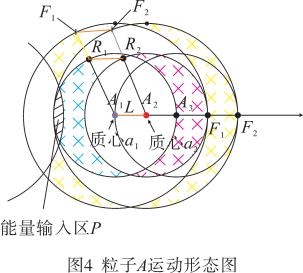Ⅰ Particle definition
A particle is the combined name of the longitudinal space endpoint and its wavelength (space) generated when the universe progresses (stretching and expanding), and the wavelength (space size and radius) value of the particle is inversely equal to its longitudinal endpoint (space depth) value (Figure 1).
Ⅱ Particle formation period
the formation period of various particles is not good to judge, such as: we usually understand that quarks constitute protons, it should be the first quarks and then protons, but there is also a possibility that there is a proton, and quarks appear in the proton when the expansion of the universe progresses, that is, in the process of the progress of the universe, its space endpoint extends deeper and produces shorter wavelengths, thereby giving birth Multiple smaller, more energetic particles (quarks), which will be further studied later. But it is certain that the “son” in all particles should be the end point of the universe, and the “son” The corresponding space is the wavelength of the particle, it should also be pointed out that: “electron” should not have a cosmic space endpoint, that is, the electron itself is not a separate particle, it is just the wavelength of the proton, which can also be called the sub-wavelength of the proton (this in our later said “sound”, “light”, “electricity”, “force” and other forms will be simply demonstrated), human beings The commonly recognized energy is actually mostly a representation of the subwavelength form of the proton.
Ⅲ Morphology of atom
When an atom is composed of multiple protons, its proton wavelength will be superposition and merge, the total length of the wave will remain the same in the same space, but the number of waves (frequency) will be equal to the number of protons, the wavelength of a single proton will be correspondingly shorter, and the single wavelength will be redshifted from inside to outside (Figure 2), the specific redshift is calculated in the “gravity” chapter later, but the total wave There will be a small difference in length, for example: the radius of hydrogen atom should be equal to the radius of iron atom, but the actual radius of hydrogen atom (0.1 nm) is slightly smaller than the radius of iron atom (0.12 nm) 0.02 nm, which is because the number of protons of iron atom is more, affected by the quark radius and the wavelength extends outward.
Ⅳ Classification of particles
There are many types of particles in terms of formation mode and formation period, such as: the particles produced by the progress of the universe are elementary particles (protons, quarks), those produced by energy release are temporary particles (photons, rays, etc.), and those produced by natural events are structurally stable particles (atoms, molecules). There could also be parent particles or shell particles (we’ll talk about that later).
Ⅴ Wavelength of particle
All particles have a wavelength (i.e. space), and the greater the total length of the wavelength, the more energy; The higher the wavelength frequency (the more wave number), the stronger the energy (the larger the energy in the same volume space). The wavelength of all particles is connected to the wavelength of the space in which the particle is located, and the external wavelength of the atom is the wavelength of the space in which the atom is located.
Ⅵ Celestial wavelength
When atoms form an aggregate (celestial body), the outer wavelengths (electromagnetic waves) of all atoms merge, resulting in the wavelength of the celestial body (celestial space), and the redshift of the celestial wavelength is the curvature of the celestial space.


Illustration:
(1)a is the cosmic terminal point of proton A
(2)b is the wavelength of proton A
(3)Protons A1, A2, A3 constitute atoms M
(4)b1, b2, b3 constitute atoms M internal wavelength and frequency
(5)b1, b2, b3 The energy level of b1, b2, b3 is redshifted outward in turn
(6)The total length of space of b1 plus b2 plus b3 should be equal to the wavelength (b) of proton A
(7)the form of proton constituent atoms is the merger of proton wavelengths, forming the wavelength and frequency within the atom
(8)there is no “electron” component in the schematic diagram, which indicates that humans will re-understand the basic structure of atoms
